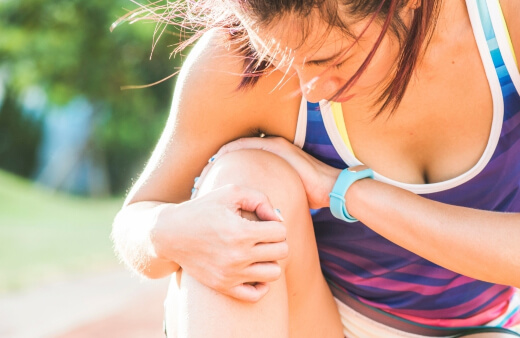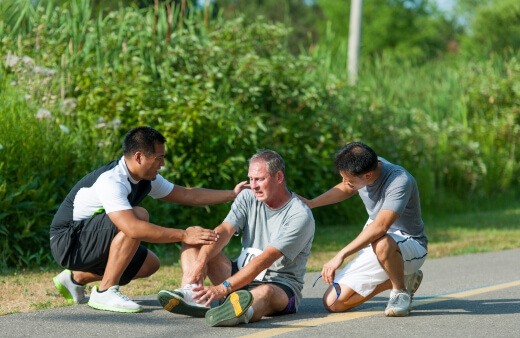If you are a runner, and you feel pain in your knees, this could be runner’s knee. This type of injury can be caused by overuse, weak hips or weak quads. Runner’s knee is one of the most common injuries in runners.
What is Runner’s Knee?
Runner’s knee is not a specific injury. The term is used to describe the pain that is felt in the knee. The pain is often a dull ache that is located on the front of the knee at the kneecap. It is also referred to as patellofemoral pain syndrome.

How is Runner’s Knee Treated?
Runner’s knee treatment will depend on the actual problem. In rare instances, your doctor may recommend surgery. To help speed up recovery, you can:
Take NSAIDS
NSAIDS are anti-inflammatory drugs. They will help relieve pain and inflammation.
Use a Compression Bandage
The use of a compression bandage will restrict the swelling.
Rest the Knee
Use your knee as little as possible. Avoid activities that will make the pain worse and aggravate the injury. These activities could include sitting or standing for long periods, running, lunging or squatting.
Elevate your Leg
When you are sitting or laying down, elevate your knee above your heart. If you are not able to get your knee above your heart, position your legs on an ottoman or pillow.
Use Ice
Ice your knee for the first 2 to 3 days. Keep the ice on your knee for 20 to 30 minutes. You can repeat this every 3 to 4 hours. Once the pain is gone, stop using the ice.
Physiotherapy
Your physiotherapist will perform an examination. They will assess your situation and determine a plan that is right for you. You will get a customised exercise program that will improve flexibility and strengthen your muscles.
Common Running Injuries and How to Avoid Them
The following are common running injuries:
Runner’s Knee
What is it?
Runner’s knee is a dull ache or pain located on the front of the knee at the kneecap. The level of pain can vary from person to person. The pain can get worse when sitting too long or exercising too much. You may notice that your knee may crack or pop when bending it.
Prevention
You are at a higher risk of runner’s knee if the muscles around your knees are weak. To help prevent runner’s knee wear shock absorbing shoes, warm-up before working out and strengthen the muscles in your knees and hips.
Treatment
Runner’s knee can often be treated with rest, elevation, ice, and compression wraps. If the pain does not subside within a couple of days, it is best to consult your doctor. They will x-ray your knee to assess the situation. They will then determine the best course of action to treat your knee. This will often involve physiotherapy.
Achilles Tendinitis
What is it?
Achilles tendinitis can be a dull or sharp pain in the ankle when running. The Achilles tendon is the tendon that hooks your heel to your calf muscle. You may also experience calf tightness and stiffness. The pain is caused by inflammation of the tendon.
Prevention
To help prevent Achilles tendonitis stretch before running.
Treatment
In most cases, Achilles tendinitis does not require surgery. Pain can last for several months. Home treatment can include rest, ice, and non-steroidal anti-inflammatory medication.
Your doctor may also want you to see a physiologist to set up an exercise regimen to strengthen the calf muscles. If untreated, the tendon can rupture, requiring surgery.

Plantar Fasciitis
What is it?
Plantar fasciitis is the inflammation of the fascia. The plantar fascia is the fibrous ligament that connects the front of your foot to your heel. When the ligament is injured, you may feel a stabbing pain when standing or a burning sensation.
Prevention
To prevent plantar fasciitis, stretch and wear shoes with support.
Treatment
It can take anywhere from 6 to 12 months for your foot to heal. Home treatments include rest, ice and non-steroidal anti-inflammatory drugs. At SSEP, we develop an exercise plan that can help strengthen the muscles in your lower legs and feet. These will help ease your pain, stabilise your muscles and prevent future injuries.
Shin Splints
What is it?
Shin splints is a term used to describe the pain experienced on the shinbone or along the inner edge of the tibia. The condition is also known as medial tibial stress syndrome. The pain occurs when the muscle’s connective tissues become inflamed.
Prevention
There are a few things you can do to prevent shin splints. These include wearing supportive shoes, stretch before running, slowly increase your workouts, exercise on soft surfaces, strengthen your foot and leg muscles, and stay at a healthy body weight.
Treatment
Shin splints will usually heal on their own over a couple of weeks. To help speed up the process and treat the pain, take a break from running, use ice packs, wrap your shins with a compression bandage, elevate your leg and use over-the-counter pain relievers.
To stay active and strengthen your muscles you can use hydrotherapy. To prevent future injuries, work with a physiologist to develop an exercise plan.
Hamstring Injuries
What is it?
Your hamstrings are tendons that attach the leg bone to the large thigh muscle. A hamstring injury is a tear or strain of the tendons. When the hamstrings are injured, your thigh may be tender to the touch, weak or stiff. You may also feel dull or severe pain.
Prevention
To prevent hamstring strains and injuries, you should always warm up before running. It is also important that you incorporate leg training that includes flexibility, resistance, and lengthening of the hamstrings.
Treatment
Hamstring injuries will usually heal on their own. To speed up the process, avoid putting weight on the leg, elevate your leg, use ice, apply a compression bandage, and take non-steroidal anti-inflammatory medication.
It is also important you begin incorporating stretching and strengthening exercises to protect yourself from future injuries.

Stress Fractures
What is it?
A stress fracture is a hairline crack in your bone. It is often caused by repetitive use. Symptoms of a stress fracture can include tenderness, pain, swelling and bruising.
Prevention
To prevent stress fractures, use supportive shoes, eat right, slowly increase your workouts, and avoid repetitive actions on the same body parts.
Treatment
Treatment of a stress fracture is to reduce weight on the leg. Your doctor may have you wear a brace or use crutches. They will diagnose your injury with the use of an X-ray, bone scan or MRI. After you begin to recover, your doctor may recommend physiotherapy to help you get back to normal.
Hip Pain
What is it?
Pain in the hip when running can be caused by a number of different factors. These can include bone fractures, osteoarthritis, labral cartilage tears, hip pointer, IT band syndrome, muscle strain, tendonitis, and bursitis.
Prevention
Stretching and strengthening are the best ways to prevent hip pain. Strength training should include the hips, quadriceps, glutes and back. You should also wear a good pair of supportive shoes that can absorb some of the shock.
Treatment
Treatment will vary depending on the cause of the pain. If you are experiencing hip pain, consult your doctor. They will run tests to see what is causing the issue. It is also important that you take a break from running. Once the pain has subsided, you can slowly reintroduce running.
How to Prevent Running Injuries
Talk to us for a rehab program or injury prevention program. At SSEP, our professional exercise Physiologists use the newest evidence-based practices when custom tailoring a program for each of our clients. We will personalise a program for you that will help you meet your goals.
Injury prevention is important for runners. If you do a lot of running or train for triathlons or marathons, talk to us about an injury prevention and athletic development program. If you have already developed an injury from running, we can help with a rehabilitation program.
We can get you back to running safely and injury free. There is no better way to prevent running injuries than strengthening and conditioning. If you are looking to improve your workout and prevent runner’s knee, give your local SSEP office a call.
